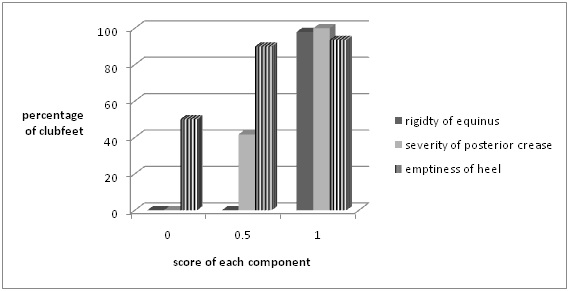Evaluation of hind foot score of Pirani scoring system in treatment of congenital talipes equinovarus by Ponseti method
Abstract
Background: Congenital Talipes Equino Varus (CTEV) is a congenital complex deformity. Pirani scoring system is most commonly used for classification. In the Ponseti technique of management, those undergoing tenotomy had higher hindfoot score compared to the non-tenotomy group. Hence evaluation of the factor in hindfoot score of the Pirani scoring system, which can predict the need for tenotomy later is important.
Materials and Methods: Hind Foot Score of Pirani Scoring System in the treatment of CTEV by Ponseti Method of serial manipulative corrective casting was evaluated on 40 Infants (up to 1 year of age) with 59 idiopathic clubfeet presenting to orthopedic surgery department of Sri Ramachandra medical college and research institute between June 2010 to June 2012.
Results: 51 out of the 59 clubfeet (40 patients) underwent tenotomy [86%]. The mean initial modified Pirani score in the tenotomy group was 4.90, and in a non-tenotomy group, it was 2.44 (p<0.005). The mean hindfoot score in tenotomy and the non-tenotomy group was 2.70 and 1.38 respectively (p <0.005). All children with the rigidity of equinus less than one were corrected by serial casting alone. 98% of clubfeet with the rigidity of equinus score 1 underwent tenotomy. The combination of the severity of posterior crease and rigidity of hindfoot showed 100% with maximum score 2 underwent tenotomy while all below 1.5 scores got corrected by casting alone.
Conclusions: Initial rigidity of equinus and severity of posterior crease of hindfoot score of the Pirani scoring system help us in predicting the need for tenotomy later. Combined score of the rigidity of equinus and severity of posterior crease can predict the need for tenotomy better than the emptiness of heel combinations. As the equinus deformity increases to a maximum and posterior crease become severe, then tenotomy is required. Level of evidence: Level 1 High-quality prospective study. The study was started before the first patient enrolled. All patients were enrolled at the same point in their disease with ≥80% follow-up of enrolled patients.
Downloads
References
2. Gray K, Pacey V, Gibbons P, et al. Interventions for congenital talipes equinovarus (clubfoot). Cochrane Database Syst Rev. 2014 Aug 12;(8):CD008602. doi: 10.1002/14651858.CD008602.pub3.[pubmed]
3. Anand A, Sala DA. Clubfoot: etiology and treatment. Indian J Orthop. 2008 Jan;42(1):22-8. doi: 10. 4103/0019-5413.38576.[pubmed]
4. Kite JH. Nonoperative treatment of congenital clubfoot. Clin OrthopRelat Res. 1972 May;84:29-38.[pubmed]
5. Ponseti IV, Smoley EN. The classic: congenital club foot: the results of treatment. 1963. Clin OrthopRelat Res. 2009 May;467(5):1133-45. doi: 10.1007/s11999-009-0720-2. Epub 2009 Feb 14.[pubmed]
6. Brand RA. Clubfoot: etiology and treatment Ignacio V. Ponseti, MD, 1914-. Clin OrthopRelat Res. 2009 May;467(5):1121-3. doi: 10.1007/s11999-009-0719-8. Epub 2009 Jan 30.[pubmed]
7. Diméglio A, Bensahel H, Souchet P, et al. Classification of clubfoot. J PediatrOrthop B. 1995;4(2):129-36.[pubmed]
8. Dyer PJ, Davis N. The role of the Pirani scoring system in the management of club foot by the Ponseti method. J Bone Joint Surg Br. 2006 Aug;88(8):1082-4. doi:10.1302/0301-620X.88B8.17482.[pubmed]
9. Pirani S, Outerbridge H, Sawatzky B, Stothers K. A reliable method of clinically evaluating a virgin clubfoot evaluation. 21st SICOT congress. 1999;29:2-30.
10. ScherDM, Feldman DS, van Bosse HJ, et al. Predicting the need for tenotomy in the Ponseti method for correction of clubfeet. J PediatrOrthop. 2004 Jul-Aug;24(4):349-52.[pubmed]
11. Aggarwal A, Gupta N. The Role of Pirani Scoring System in the Management and Outcome of Idiopathic Club Foot by Ponseti Method. IJSR. 2016;5(6):1284-7.[pubmed]
12. David BH , Olayinka O A, Oluwadare E, et al. Predictive value of Pirani scoring system for tenotomy in the management of idiopathic clubfoot. J Orthop Surg (Hong Kong). 2017 May-Aug;25(2):2309499017713896. doi: 10.1177/2309499017713896.[pubmed]
13. Chueire AJ, Carvalho Filho G, Kobayashi OY, Carrenho L. Treatment of congenital clubfoot using Ponseti method. Rev Bras Ortop. 2016 May 4;51(3):313-8. doi: 10.1016/j.rboe.2015.06.020. eCollection 2016 May-Jun.[pubmed]
14. Ponseti IV. Treatment of congenital club foot. J Bone Joint Surg Am. 1992 Mar;74(3):448-54.[pubmed]
15. Dobbs MB, Nunley R, Schoenecker PL Long-term follow-up of patients with clubfeet treated with extensive soft-tissue release. J Bone Joint Surg Am. 2006 May;88(5):986-96. doi:10.2106/JBJS.E.00114.[pubmed]
16. Wainwright AM, Auld T, Benson MK, Theologis TN. The classification of congenital talipes equinovarus. J Bone Joint Surg Br. 2002 Sep;84(7):1020-4.[pubmed]
17. Cooper DM, Dietz FR. Treatment of idiopathic clubfoot. A thirty-year follow-up note. J Bone Joint Surg Am. 1995 Oct;77(10):1477-89.[pubmed]



 OAI - Open Archives Initiative
OAI - Open Archives Initiative


















 Therapoid
Therapoid

